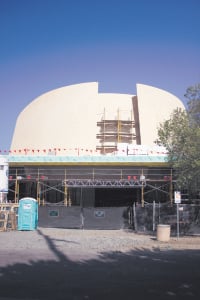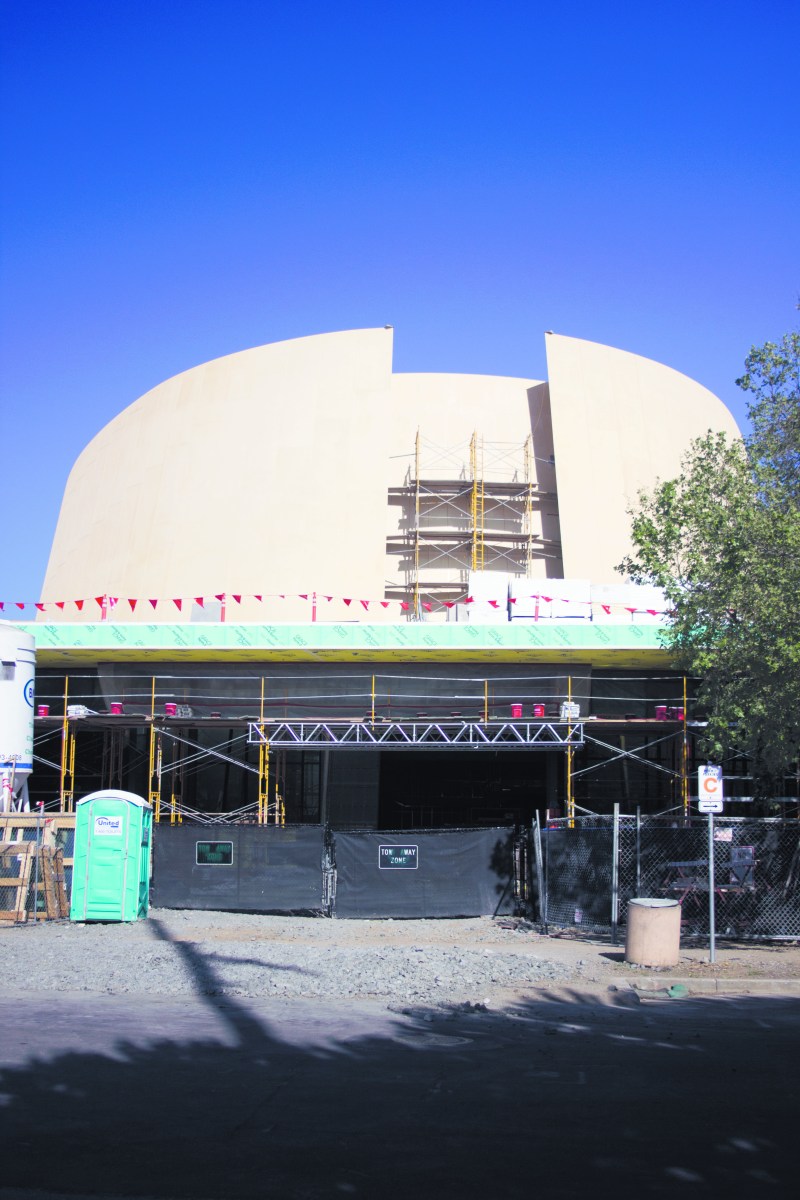
A groundbreaking ceremony on Tuesday afternoon marked the start of construction on the museum building that will eventually house the Anderson Collection, “one of the most outstanding private collections of 20th century American art in the world” according to University Provost John Etchemendy, Ph.D. ’82.
The collection was donated to Stanford by the Anderson family: Harry “Hunk” W. Anderson, Mary “Moo” Margaret Anderson and their daughter Mary “Putter” Patricia Anderson Pence. The Andersons, along with Provost Etchemendy, held gold-plated shovels at the ceremony to break ground for the new building.
Ennead Architects, the firm that designed the Cantor Arts Center extension in 1998, the Stanford Law School William H. Neukom Building in 2011 and the Bing Concert Hall, which is scheduled for completion in January 2013, also designed the 33,327-square-foot Anderson Collection building. Current designs depict a two-story building split into three different parts, with open space exhibition of the collection’s pieces. The architects designed the exterior to complement the neighboring Cantor Arts Center and surrounding landscape. The Board of Trustees approved the design in June 2012.
The new building is expected to cost approximately $30.5 million and will be open to the public in 2014. It will be located north of the Cantor Arts Center, at the corner of Lomita Drive and Campus Drive.
The Anderson collection is the culmination of over 50 years of finding and purchasing art. According to Etchemendy, the Andersons asked themselves “Have we seen it before, and could we have thought of it?” when considering purchasing a new piece of art. This strategy resulted in a collection containing 121 works by 86 post-World War II American artists such as Jackson Pollock, Wayne Thiebaud and Franz Kline.
“This collection is one of the most valuable and significant to be donated to any University, and it is unparalleled in Stanford’s 127-year history,” Etchemendy said. “It’s almost impossible to describe the profound effect that this gift of their collection will have on Stanford.”
Roberta Denning, M.S. ’75, wife of Steven Denning, the chair of the Board of Trustees, expressed her hope that the collection will “dissolve the outdated boundaries between the arts and other disciplines” and make famous works of art more accessible to Stanford students.
“An encounter with Pollock’s drips and Rothko’s reds will be a short bike ride away from the freshman dorm,” Denning said.
Alexander Nemerov, provostial professor of arts and humanities, who spoke at the groundbreaking ceremony, said the Anderson Collection and the rest of the ‘Arts District,’ which will include the Cantor Arts Center, the Bing Concert Hall and the McMurtry Building, will be a source of inspiration for Stanford’s students of the arts.
“Any such extraordinary addition to what is available to Stanford students must give them that much more of a chance to succeed in their lives, to seek their highest aspirations and truly to make a mark on the world,” Nemerov said.
Nemerov used one of the collection’s most notable pieces, Jackson Pollock’s “Lucifer,” as an example of a piece that will stimulate discussion and encourage a deeper analysis of art.
“[The Andersons] have given to Stanford, in this one painting, one of Shakespeare’s sentences,” Nemerov said. “That’s the import of what we’re here to honor and celebrate.”
Members of the Anderson family expressed gratitude to Stanford officials, particularly University President John Hennessey, for giving their collection a home. The Andersons said that they had always considered themselves custodians of the works and wanted a place where the collection could be viewed and appreciated on an international scale.
“Thank you Stanford University for making our dreams come true,” a teary Mary Patricia Anderson Pence said.
Mary Margaret Anderson noted that their donation to Stanford was “closing the circle” of a journey that started when the Andersons began collecting art and sought the guidance of late Stanford professor and leading art historian Albert Elsen.
The Andersons took Elsen’s class, Art 101, which “gave [them] the fuel to go on and really look at art,” according to Mary Margaret. Elsen often visited the Anderson home to evaluate art they had purchased and give them advice. Though he died in 1995, Mary Margaret credited him for helping them assemble a collection that “enriched [their] lives.”
In his speech at the ceremony, Harry Anderson thanked Burt McMurtry, namesake of the McMurtry Building, for “reopening discussion” with the Andersons in 2004 about donating art. Harry echoed his wife’s belief that the collection belongs at Stanford.
“During the past eight to 10 years, the Andersons began to feel as if the collection is not just for the Andersons, it is for the world,” Harry Anderson said. “Stanford is really the place for it to be.”
